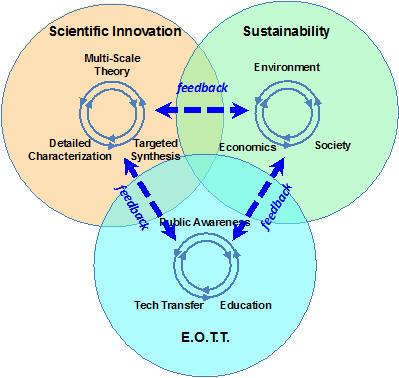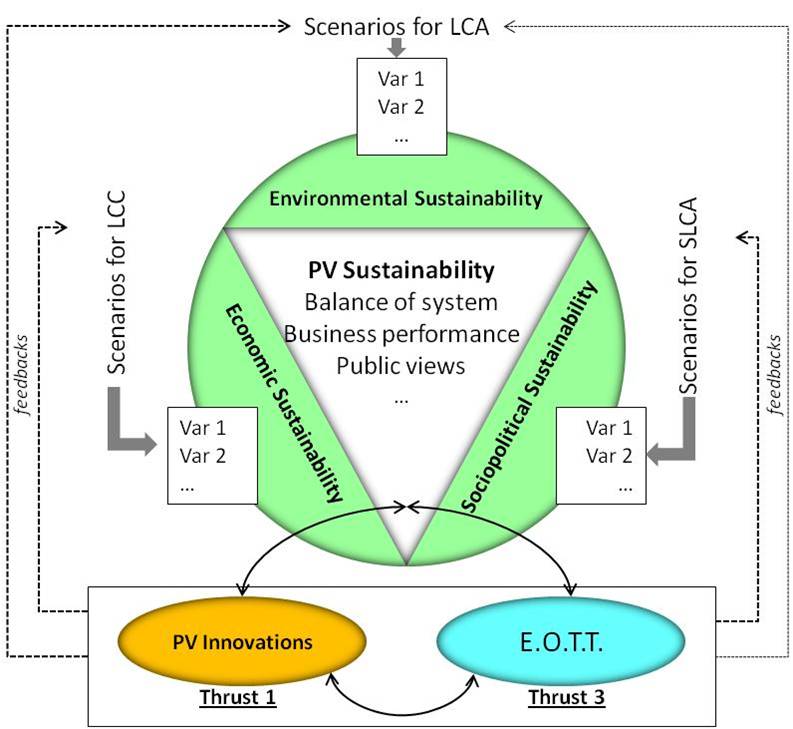Earth-Abundant Thin-Film Solar Cells as a Sustainable Solar Energy Pathway
Project Overview
The majority of the 15 terawatts (1012 W) of new power needed across the globe by 2050 must come from CO2 –free sources. Solar photovoltaic electricity technology is considered one of the top choices to meet this need, but must be made sustainable from economic, environmental, and societal perspectives. Our objective is to develop the concepts, materials, and processes necessary to economically produce environmentally friendly thin-film solar cells from earth-abundant, environmentally benign (EAEB) materials. We have assembled a multi-disciplinary team representing the disciplines of physics, materials science, engineering, chemistry, socioeconomics, environmental science, and education to address these complex issues.
To create an Sustainable Energy Pathway (SEP) based on solar energy generated by EAEB materials, we will integrate systematic sustainability analyses that include:
- Quantification of the environmental and societal impacts;
- Identification of economically viable directions; and
- Comprehensive education and outreach activities.
These goals will be achieved through: Thrust 1: Scientific and technology innovation in earth-abundant, thin-film solar cells; Thrust 2: Sustainability assessment of the new technology and products; and Thrust 3: Education, Outreach, and Technology Transfer (E.O.T.T.) of the new technology and products may introduce added costs to a particular solar cell technology.
We will systematically analyze the sustainability of our new solar cell systems and manufacturing process through life cycle sustainability assessments (LCSA) of viable environmental, economic, and sociopolitical (EES) measures. We will develop and implement a dynamic, reiterative working flowchart where different scenarios will be re-iteratively generated and assessed by our research team and the stakeholders of PV systems, followed by a sound, integrated LCSA and structural equation modeling (SEM) framework. To address education/workforce development, we will target critical educational goals for students at all levels. Seven doctoral and six undergraduate students will be supported by this project each year. These students will have a primary faculty advisor but be advised by a group of faculty in each thrust area. This approach will further reinforce synergy, broaden educational goals, and build a true team philosophy.
This project will yield at least two scientific impacts:

As an outgrowth, we expect to develop an understanding of environmental, societal, and economic issues so that recommendations can be made to ensure that earth-abundant solar cell technologies will lead to a sustainable solar energy pathway. The proposed approach will be broadly and transformatively applicable in assessing the sustainability of other solar cell technologies and manufacturing processes as well as other renewable energy pathways.
Conceptual Framework and Hypothesis

Pictured above is our proposed conceptual framework for understanding the sustainability of a viable PV system, which is collectively defined by the Environmental, Economic, and Sociopolitical (EES) triangle. Critical measures for each of the EES scenarios will be generated from the LCSA from inputs of Thrust 1 (Task 2.1). The changes in EES sustainability will be independently modeled with LCSA (Task 2.2) and integrated using various structural equation models (SEMs) (Task 2.3).
A set of initial scenarios for EES sustainability will be independently modeled with quantitative measures for the variables for each life cycle phase of the PV systems, including efficiency breakthroughs, choice of raw materials, solar cell configuration, and manufacturing protocols. A preliminary list of parameters that will be varied is shown in the above figure.
For example, in the first life cycle phase, required raw materials will be varied. These materials include not only the proposed EAEB materials but also other materials (e.g., solvents and powders used in cell synthesis and other materials used in module manufacturing and maintenance). In the second and third phases of LCSA, material synthesis and module fabrication and manufacturing protocols will be varied. We will also develop different scenarios for the balance of system (BOS) because the different EAEB thin-film cells may require different amounts of support and other BOS components. Similarly, the installation, use, and end-of-life management parameters are expected to be different among the EAEB materials and from other PV systems. As shown in the figure above, the number of scenarios increases rapidly as different parameter combinations and values are used in each one of the LCSA phases.
Data
LCA Model Download
Provided below are the statistic models we used for the paper entitled 'Causality in Social Life Cycle Impact Assessment (SLCIA)', which was published in Int. J of Life Cycle Assessment in July 2015. There are three statistic models we used for the paper: one Partial Least Square-SEM model, one covariance based-SEM, and one Bayesian network model. The detailed description on each model and the software used can be found in the 'readme' file. Download LCA Software Files
Economic Data
Environmental
- EPBT
- Mineral Database
- Overview Summaries of Alternative Material for New Concept Solar Cell
- Global NPP
Social
Publications and Presentations
Publications
- Collier, J., S. Wu, and D. Apul. 2014. Life cycle environmental impacts from CZTS and Zn3P2 thin film photovoltaic cells. Energy 74: 314-321.
- Wu, R., D. Yang, and J. Chen. 2014. Social life cycle assessment revisited. Sustainability 6(7): 4200-4226.
- Wu, S.R., Chen, J., Apul, D., Fan, P., Yan, Y., Fan, Y. and Zhou, P., 2015. Causality in social life cycle impact assessment (SLCIA). The International Journal of Life Cycle Assessment, 20(9), pp.1312-1323.
- Fan, Y., Wu, R., Chen, J. and Apul, D., 2015. A Review of Social Life Cycle Assessment Methodologies. In Social Life Cycle Assessment (pp. 1-23). Springer Singapore.
- Wu, S.R., M. Greaves, J. Chen., and S. Grady. 2017. Green buildings need green occupants: A research framework through the lens of the Theory of Planned Behavior. Architectural Science Review 60(1): 5-14.
- Wu, R., P. Fan, and J. Chen. 2016. Incorporating culture into sustainable development: A cultural sustainability index framework for green buildings. Sustainable Development 24(1): 64-76.
- Fan, Y, J. Chen, G. Shirkey, R. John, R. Wu, H. Park, C. Shao. 2016. Applications of structural equation modeling (SEM) in ecological research: An updated review. Ecological Processes 5:19.
- Wu, S.R., X. Li, D. Apul, V. Breeze, Y. Tang, Y. Fan, and J. Chen*. 2017. Agent-based modeling of temporal and spatial dynamics in life cycle sustainability assessment. Journal of Industrial Ecology.
- Wu, S. R, S. K. Kim, H. Park, P. Fan, A. Ligmann-Zielinska, and J. Chen*. 2017. How green buildings communicate green design to the building users? A survey study on a LEED-certified building. Journal of Green Building 12(3): 85-100.
- Fan, Y., Beyza, G., Chen, J., Wu, S.R., Zhou, P., 2016. Pro-environmental behaviors and knowledge: A case study of park visitors in Toledo, Ohio. Environmental Protection and Ecology (revision submitted).
- Wu, S.R., I. Celik, and D. Apul. A social handprint/footprint calculation framework for resource extraction industry: a case study on comparing two major PV technologies in the U.S. Journal of Clean Productions (in preparation).
- Wu, S.R., J. Chen, and others. Human-environment interaction and the behavioral consequences in sustainability. Nature-Sustainability (in preparation).
Presentations
- Yan, Y et al. 5/6/2013. Earth Abundant Thin-Film Solar Cells as a Sustainable Solar Energy Pathway. , UT project meeting.
- Chen, J et al. 5/6/2013. Thrust 2: Sustainability Assessment of the New PV Technology and Production, UT project meeting.
- Apul, D et al. 5/6/2013. LCA of Si and Thin Film PV Systems: Impacts from Water, Toxicity, Embedded Energy, and Global Warming.
- Chen, J. 4/18/2013. Harmonizing human and nature for the changing globe. Lake Erie Public lecture.
- Fan, Y. Demand for solar electricity from the BRICS countries in the future. American Geography Union Fall Meeting, San Francisco, 2015.
- Wu, S.R., M. Green, J. Chen, A. Yang, and Y. Tang. Green building design and visual persuasion on occupants’ pro-environmental behaviors. In proceedings of the 49th International conference of the Architectural Science Association, , Melbourne, pp. 133-142, December 2-4, 2015.
- Chen, J. Harmonizing people and nature. Invited Seminar Series, Huadong Normal University, August 2, 2015.
- Chen, J. Harmonizing nature and people. Hanover Seminar Series (invited), Dept. of Forestry, MSU. March 17, 2015.
- Chen, J. Renewed Challenges: People vs Environment. Wenzhou University, November 4, 2016.
Team Members
| Dr. Jiquan Chen | Professor, Michigan State University | jqchen@msu.edu |
| Dr. Defne Apul | Associate Professor, University of Toledo | defne.apul@utoledo.edu |
| Ruqun Wu (Susie) | PhD Student, Michigan State University | ruqunvi@hotmail.com |
| Yi Fan (Angela) | PhD Student, Michigan State University | fanyi2@msu.edu |
Contact
Center for Global Change and Earth Observations
202 Manly Miles Bldg. 1405 South Harrison Road Michigan State University, East Lansing, MI 48823


